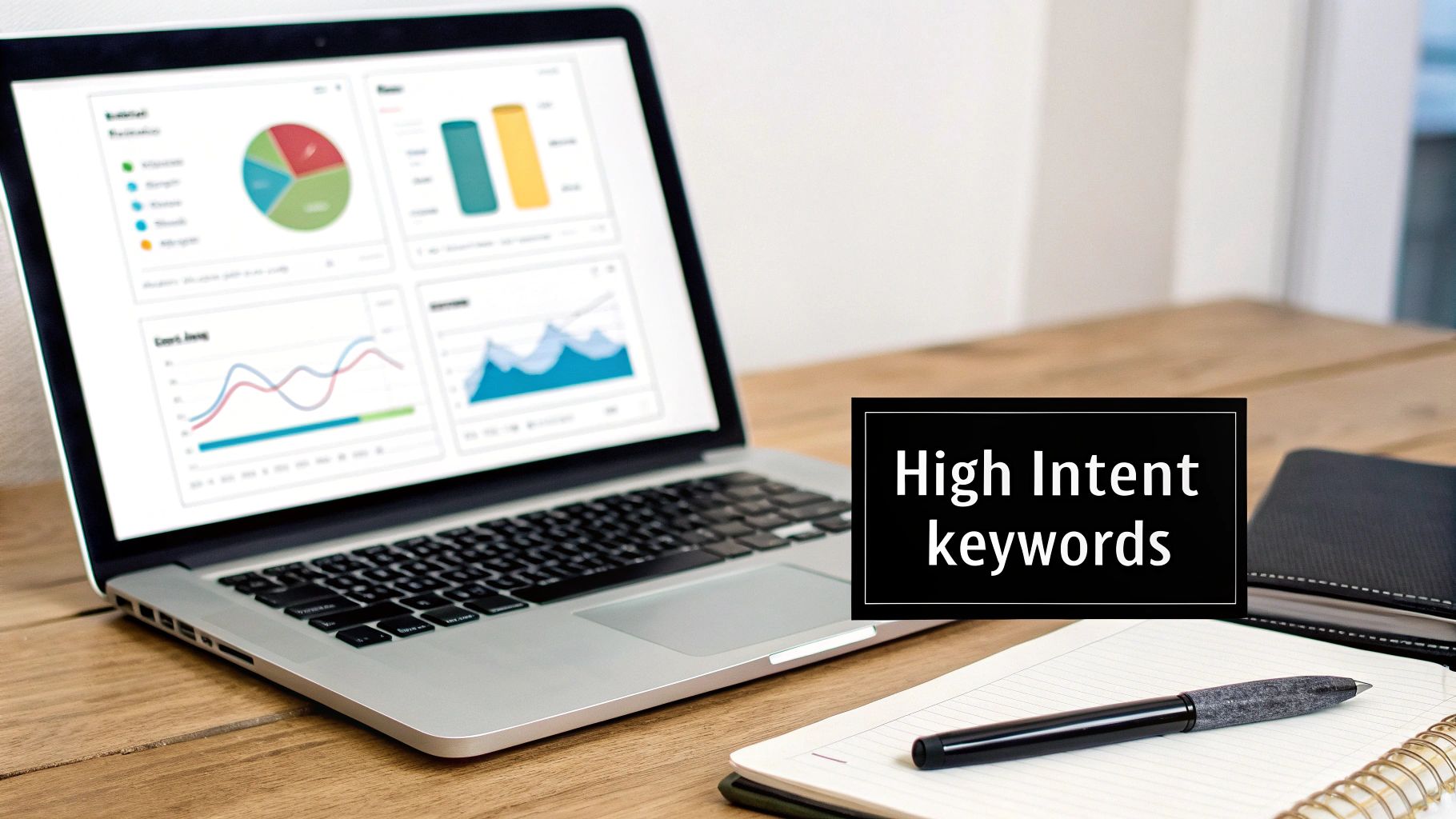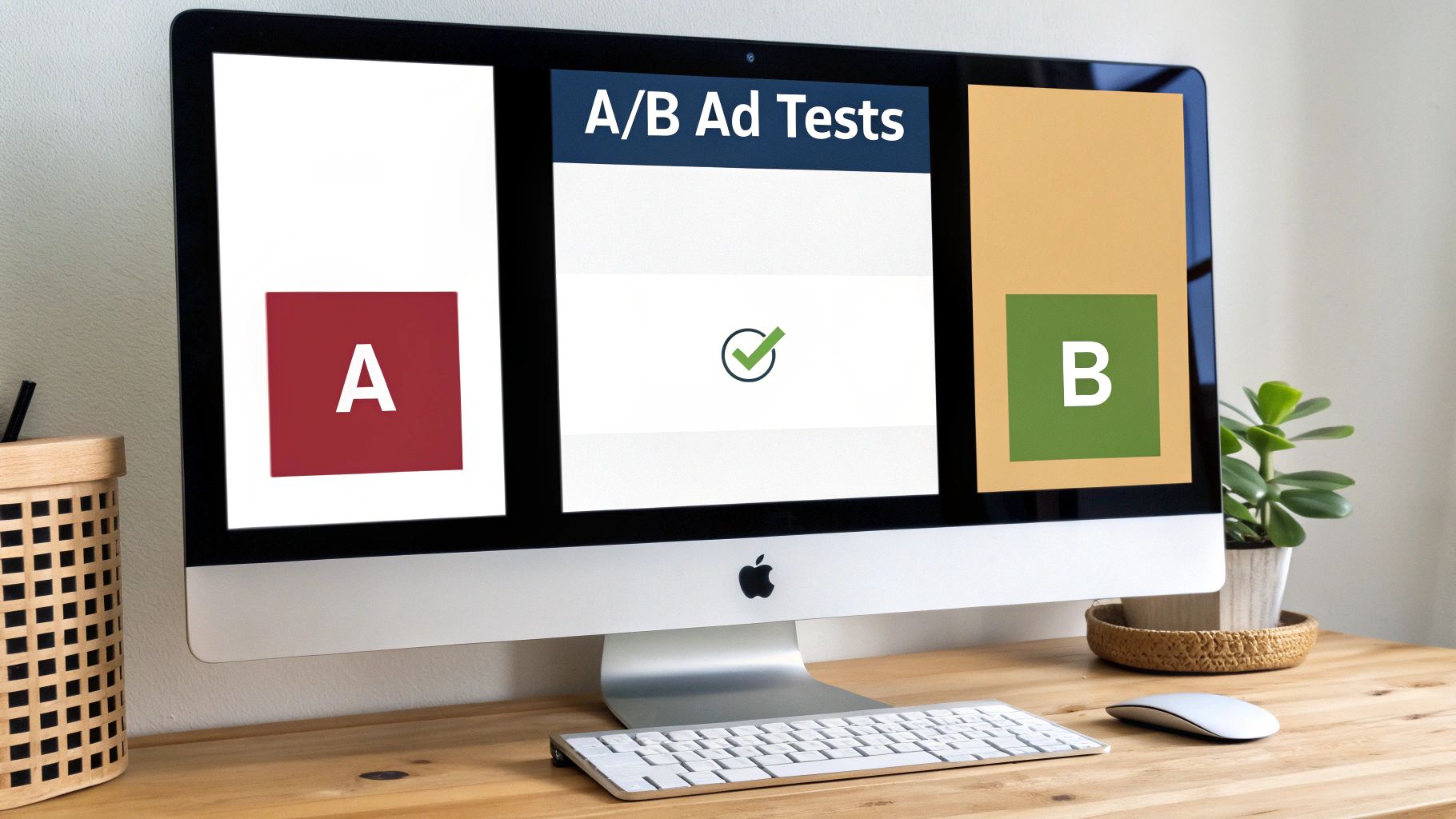Stay Updated with Everything about MDS
Thank you! Your submission has been received!
Oops! Something went wrong while submitting the form.
Chilat Doina
October 31, 2025
In the hyper-competitive e-commerce market, simply running ads is no longer a viable path to success. The critical difference between burning through your marketing budget and achieving profitable returns hinges on a sophisticated, data-driven approach to paid advertising. Generic tactics yield generic results; real growth requires a deliberate and strategic plan. This article moves beyond the basics to unveil 10 powerful pay per click strategies that top e-commerce entrepreneurs use to systematically dominate their markets.
You will learn specific, actionable methods for every stage of your campaign. We will cover advanced keyword selection, Quality Score optimization, and high-converting ad copy testing. You’ll also get insights into intelligent bidding automation and conversion-centric landing page design. These proven tactics are designed to lower your customer acquisition costs (CAC) and significantly maximize your return on ad spend (ROAS). To further enhance your e-commerce growth, explore additional insights on 8 pay per click strategies for 2025.
Prepare to transform your campaigns from an unpredictable expense into a reliable, scalable growth engine for your brand. Let's dive into the strategies that will give you a decisive competitive edge.
A powerful keyword research and selection strategy is the bedrock of any successful PPC campaign. This foundational process involves identifying and targeting the specific search terms your ideal customers use when they are ready to buy. It's not just about finding high-volume keywords; it's about uncovering high-intent phrases that align directly with your e-commerce products and business goals. A methodical approach ensures your ad spend is directed toward clicks that are most likely to convert into sales.

This pay per click strategy is essential from the very start. Before you even create an ad, you need to understand the search landscape. For an e-commerce store, this means targeting transactional keywords like "buy organic dog food online" or specific product model numbers. The goal is to match your ad's message precisely to the user's search intent, which dramatically increases relevance and click-through rates.
A strong Quality Score optimization strategy is one of the most powerful levers for improving the efficiency of your pay per click strategies. Quality Score is Google's rating of the quality and relevance of your keywords, ads, and landing pages. A higher score means Google sees your ad as more valuable to users, which directly translates into lower cost-per-click (CPC) and better ad positions. For e-commerce sellers, a high score is a competitive advantage, ensuring your budget stretches further and drives more profitable traffic.
This strategy is crucial because it fundamentally impacts your campaign's financial performance. It's not just about bidding higher; it's about winning auctions more efficiently. An e-commerce brand that consistently achieves a Quality Score of 9 or 10, for example, can pay significantly less per click than a competitor with a score of 5 for the same ad rank. This means you can achieve top visibility without simply outspending everyone else, maximizing your return on ad spend (ROAS).
Even with the best keywords, an e-commerce campaign can fail without compelling ad copy that persuades users to click. An ad copy testing and optimization strategy involves a systematic approach to creating, testing, and refining your ad text to maximize click-through rates (CTR) and conversions. It's about scientifically discovering what headlines, descriptions, and calls-to-action resonate most deeply with your target audience, directly improving your PPC performance and return on ad spend.

This pay per click strategy is critical for continuous improvement. Simply launching ads and letting them run is a recipe for stagnation. For an online store, this could mean A/B testing a headline that focuses on "Free Shipping" versus one that highlights a "5-Year Warranty." Small changes can lead to significant uplifts in performance, as demonstrated by companies like Slack, which tested value propositions and found that "organized workspace" resonated better than other phrases.
A sophisticated bidding and automation strategy moves beyond manually setting cost-per-click (CPC) bids and leverages machine learning to optimize for specific business outcomes. This approach involves selecting an automated bid strategy that aligns with your campaign goals, such as maximizing conversions or achieving a target return on ad spend (ROAS). By allowing platforms like Google Ads to adjust bids in real-time based on countless user signals, you can enhance performance and efficiency at a scale that is impossible to manage manually.
This pay per click strategy is crucial for scaling your e-commerce advertising efforts profitably. For example, a retailer can use a Target ROAS strategy to instruct Google's algorithm to aim for a specific return, like $4 in revenue for every $1 spent on ads. This ensures that ad spend is automatically allocated toward the auctions most likely to drive high-value sales, directly impacting your bottom line without constant manual adjustments.
A landing page optimization strategy ensures that the traffic you pay for has the highest possible chance of converting into customers. This crucial pay per click strategy involves creating dedicated, highly relevant pages that directly correspond to your ad's message and the user's search intent. Sending paid traffic to a generic homepage is a recipe for wasted ad spend; instead, a focused landing page removes distractions and guides the user toward a single, specific action, significantly boosting conversion rates and Quality Scores.

This strategy is essential for maximizing your return on ad spend (ROAS). A well-optimized landing page provides a seamless experience from ad click to conversion, reinforcing the value proposition and making it easy for users to take the next step. Companies like Unbounce have shown that businesses can achieve 2-3x improvements in conversion rates simply by using dedicated landing pages tailored to specific ad groups.
A sophisticated audience targeting and segmentation strategy moves beyond keywords to focus on the who behind the search. This approach involves leveraging user data to deliver highly relevant ads to specific groups, dramatically improving campaign performance and return on investment (ROI). Instead of showing the same ad to everyone, you segment users based on demographics, interests, past behaviors, and similarities to your best customers, ensuring your message resonates deeply with each distinct audience.
This pay per click strategy is crucial for scaling campaigns efficiently. For an e-commerce business, it allows you to target high-income demographics with premium products, remarket to users who abandoned their carts, or find new customers who behave like your most loyal buyers. Platforms like Google Ads and Meta Ads offer powerful tools to layer these audiences, creating a precise targeting matrix that minimizes wasted ad spend and maximizes conversions.
A robust conversion tracking and attribution strategy is the crucial link between your ad spend and actual business results. This essential practice involves systematically monitoring and attributing valuable user actions, like purchases or sign-ups, directly to your PPC campaigns. Without it, you're flying blind, unable to distinguish profitable pay per click strategies from those that waste your budget. Proper implementation allows you to accurately calculate ROI, optimize for high-value actions, and make data-driven decisions about where to allocate your funds.
This strategy is non-negotiable for understanding campaign performance. For an e-commerce store, it’s not just about knowing an ad generated a click; it's about tracking which specific ad led to a $200 purchase versus a $20 one. This level of detail empowers you to optimize your campaigns for maximum profitability, ensuring every dollar spent is accountable and contributes directly to your bottom line.
An effective negative keywords and exclusion strategy is one of the most powerful tools for improving campaign efficiency and protecting your ad spend. This proactive approach involves telling advertising platforms which search terms you don't want your ads to show for. It’s a critical pay per click strategy that refines your targeting, ensuring your budget is only spent on clicks from users with genuine purchasing intent, thereby boosting your return on investment.
This strategy is not a one-time setup but an ongoing process of optimization. For an e-commerce brand selling high-end "leather messenger bags," excluding terms like "free," "repair," or "DIY tutorial" prevents you from paying for clicks from users who aren't looking to buy. By filtering out this irrelevant traffic, you ensure your ads are shown to a more qualified audience, which directly improves conversion rates and overall campaign profitability.
A proactive seasonal and promotional campaign strategy allows e-commerce businesses to capitalize on predictable consumer behavior spikes tied to holidays, events, and seasonal changes. This approach involves preparing dedicated PPC campaigns well in advance to capture heightened search demand and purchase intent. Instead of reacting to trends, you strategically align your ad copy, offers, and bidding with specific timeframes like Black Friday, Back-to-School, or summer sales events.
This is a critical pay per click strategy for maximizing revenue during peak shopping periods, which for many retailers can account for a significant portion of annual sales. By planning ahead, you can launch highly relevant and timely campaigns that resonate with shoppers who are actively looking for deals and specific seasonal products. For example, a campaign targeting "Black Friday laptop deals" in November will perform far better than a generic ad because it directly meets the user's immediate, time-sensitive need.
A mobile-first optimization strategy acknowledges the reality that the majority of your customers first encounter your brand on a smartphone. This approach involves designing your entire PPC funnel, from ad creative to landing page, specifically for the mobile experience. It’s no longer enough for your site to be mobile-friendly; your campaigns must be mobile-native, built to capitalize on the unique behaviors and expectations of users on the go. This is a critical pay per click strategy for capturing an increasingly mobile-centric market.
This strategy is vital because the user journey on a mobile device is fundamentally different from that on a desktop. Mobile users are often looking for immediate answers, quick checkout processes, and easy navigation. For an e-commerce store, this means ensuring your ads lead to lightning-fast, thumb-friendly landing pages. Companies like DoorDash and Uber excel at this, using location-based targeting and simple, action-oriented mobile interfaces to convert user intent into immediate sales.
The journey from a fledgling e-commerce store to a market-leading brand is not paved with a single "silver bullet" solution. Instead, it is built upon the consistent and intelligent application of a multifaceted advertising approach. We have explored ten powerful pay per click strategies, moving from the foundational pillars of keyword research and Quality Score optimization to the sophisticated nuances of audience segmentation, conversion attribution, and mobile-first design. Each strategy represents a critical lever you can pull to drive more profitable traffic, increase conversions, and ultimately, scale your business.
Merely understanding these concepts is not enough. The true differentiator between average advertisers and top-tier performers lies in the integration and continuous refinement of these tactics. Think of your PPC campaigns not as a set of disconnected tasks, but as a dynamic, interconnected ecosystem. Your ad copy tests should inform your landing page optimizations. Your audience segmentation should refine your bidding strategies. Your negative keyword lists are just as crucial as your primary targets. This holistic view is what transforms a good advertising account into a great one.
The most common mistake e-commerce founders make is trying to implement everything at once. This often leads to overwhelm and a lack of meaningful progress. The key is to build momentum through a structured, iterative process. Your immediate next step is to identify the single biggest opportunity for improvement within your current campaigns.
By tackling one area at a time, you can make measurable improvements, learn from the data, and then apply those insights as you move to the next strategic pillar. This methodical approach ensures sustainable growth and prevents the chaotic, reactive decision-making that plagues so many ad accounts.
Mastering these individual pay per click strategies will undoubtedly set you apart from your competitors. However, achieving 7, 8, or even 9-figure success requires more than just technical skill; it requires a strategic mindset powered by continuous learning and peer-driven insights. The landscape of digital advertising is in constant flux, and the strategies that work today may be obsolete tomorrow. Your commitment to testing, adapting, and evolving is the ultimate competitive advantage. Take one strategy from this list, implement it this week, and begin building the momentum that defines an elite e-commerce brand.
For entrepreneurs committed to scaling to the highest level, surrounding yourself with a trusted network of peers is a critical growth accelerator. The Million Dollar Sellers community provides the exclusive, behind-the-scenes insights and vetted strategies you need to turn advanced PPC tactics into sustained, profitable growth. To learn from and network with the top 1% of e-commerce sellers, explore joining Million Dollar Sellers.
Join the Ecom Entrepreneur Community for Vetted 7-9 Figure Ecommerce Founders
Learn MoreYou may also like:
Learn more about our special events!
Check Events